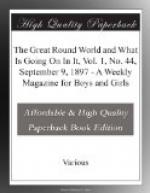Putting away the dead in mound-graves, besides being a universal custom, was one which endured through a long series of centuries, since their contents illustrate for us the Age of Bronze through all its gradations and a goodly portion of the Age of Iron—i.e., the beginnings of the age in which we live ourselves.
To decide which mound belongs to a later and which to an earlier period is easy, from the variety and quality of the articles, which bear witness to the degree of culture of the builders, though it is of course difficult even to give a guess in figures at just how long ago, at least, the earlier mounds were built.
These are all times which knew not of writing. Therefore we have no history of them; for history is made up of two elements: things that happen, and writers who record them. So when we speak of “historic times,” we mean the times since writing came into general use. All that went before we class as “prehistoric” times, i.e., times of which we can have no history. It is clear, then, that if, of two countries, one knows writing and uses it to register what happens to it, while the other does not, the former will be living in historic, the latter in prehistoric times.
More than that: there are plenty of peoples now living in—for them—prehistoric times. Take all the savage tribes still scattered over land and sea in many parts of the world. Just as there are enough South Sea Islanders for whom the Age of Stone is not over yet, since they still use flint, bone, and fishbone for their tools and weapons, and what metal they have comes to them through barter from Europeans or Americans. Captain Cook—or some other noted voyager and discoverer—received as a present from a South Sea chieftain a flint axe, beautifully shaped and polished like a mirror. The chief told his white friend it had taken fifty years to produce that polish, his grandfather, his father, and himself having worked on it at odd moments of leisure!
And yet, when we speak of “historic” and “prehistoric” times, we never think of all these races; they do not count among the so-called “culture-races,” because they have produced no civilization of their own, have done nothing to advance the work of the world, added nothing to its treasury; in short, they have not helped to make history.
Just one word more about these prehistoric ages and the memorials they have left of themselves. No matter how various the stages of human culture which these latter betray, one feature is common to all, back to the most primitive feasting-places of the cave-dwellers; it is—the knowledge and use of fire. Yet there most certainly was a time when men had not yet learned to produce and to handle this marvellous force of nature, their most helpful friend and most destructive foe. Can we picture to ourselves how miserable and degraded, how distressingly like that of other forest animals must have then been the condition of those who yet were the fathers of the coming human race? Hardly. Our imagination itself stands still, helpless and puzzled, before a state of things so remote, so utterly beyond our power to realize and compare.




